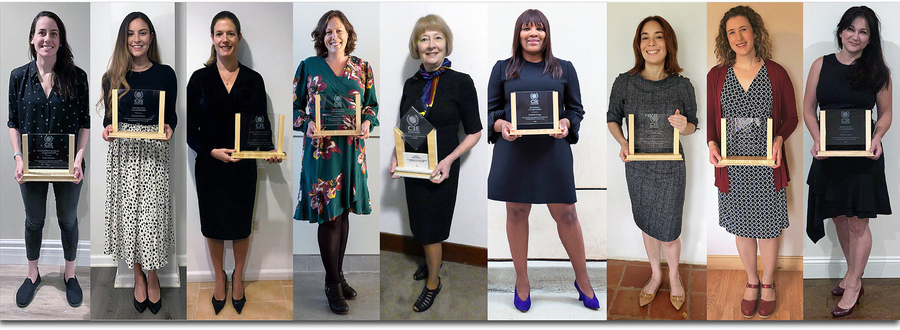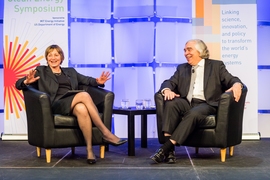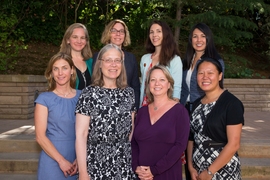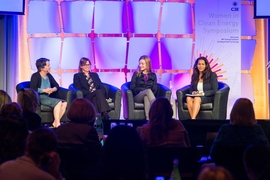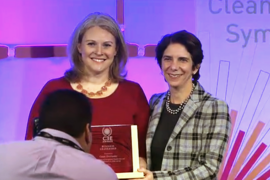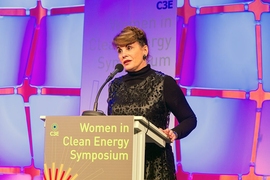“Some say working on climate is a marathon, not a sprint, but it’s more an ultramarathon — an endurance sport if ever there was one,” said Kate Gordon, the senior climate policy advisor to Governor Gavin Newsom of California. “And look, women excel at those: We know how to dig in and get stuff done.”
Gordon’s remarks in her first-day keynote address set the tone for the ninth annual U.S. Clean Energy Education & Empowerment (C3E) Symposium and Awards, held virtually in December. The event brings together women researchers, government leaders, and entrepreneurs to share their insights and goals around moving the world to a low- and eventually carbon-free future. It also honors nine women for their outstanding leadership and accomplishments in clean energy.
The MIT Energy Initiative (MITEI) hosted the event, in collaboration with the U.S. Department of Energy (DOE), the Stanford Precourt Institute for Energy, and the Texas A&M Energy Institute.
The symposium is part of the broader U.S. C3E initiative to increase women’s participation in the clean energy transition. “While women make up about half of the total U.S. labor force, they comprise less than a third of those employed in the renewable energy sector,” said Maria T. Vargas, the senior program advisor for the Office of Energy Efficiency and Renewable Energy at the DOE, who leads the agency’s involvement in C3E. “This gender gap is continuing to grow as wage inequities and inadequate advancement opportunities prompt many to seek work elsewhere, depriving the energy sector of their talent, experience, and skills.”
“It’s no longer about fairness and equality, but about increasing our chances of success in making strategic decisions around climate mitigation and adaptation,” added Martha Broad, MITEI executive director, in her opening remarks. “In order to meet a net-zero carbon emissions goal within the next few decades and fundamentally change the way we produce and consume energy, it’s obvious we need to have women at the table,” she said.
An opportunity for deeper structural transformation
The two-day event took place at the tail end of a year like no other: unprecedented environmental destruction from climate change, the Covid-19 pandemic, an economic downturn. The symposium acknowledged these complex and interlinked issues, inviting its participants to consider the topic, “Accelerating the clean energy transition in a changing world.”
But for many women speaking in panel discussions and presentations, accelerating this transition was not so much a matter of reacting to a changing world as it was changing that world. Without gender equality, racial and economic justice, they made clear, the most ambitious climate mitigation and adaptation plans would sputter.
The eight U.S. C3E mid-career award winners, professionals with outstanding accomplishments and leadership abilities, spoke passionately about expanding the reach of clean energy technologies to transform lives.
Elizabeth Kaiga, recipient of the 2020 business leadership award, is an account director for Renewable Energy, DNV GL. “Energy transition and a more inclusive future are intertwined,” she said. “We must provide equitable access for underrepresented communities.” Kaiga plans to use her award to help train women living in off-grid communities in Africa to deliver electricity directly to their homes.
This year’s international leadership award winner, María Hilda Rivera, grew up in Puerto Rico without reliable electricity. Today, as energy advisor for Power Africa, she is providing electricity to poor communities in sub-Saharan Africa. “To meet the needs of these end users, we are building and growing energy markets, with minigrids and batteries delivered to homes,” she said.
Advocacy awardee Cristina Garcia, assistant director of New York City’s Building Electrification Initiative, strives to “increase inclusivity with those disproportionately excluded from the conversation about climate change,” she said. She provides internship and job opportunities in the sustainability field to Latino students. “We need all hands on deck, with gender, ethnic, and racial diversity, to generate better outcomes.”
In a panel devoted to equitable access to clean energy, speakers hammered home the importance of ensuring underserved communities’ ownership of policy, design, resource allocation, and economic benefits. “We can’t have big wins on climate without having front-line engagement,” said Shalanda H. Baker, a professor of law, public policy, and urban affairs at Northeastern University. “The energy transition is an opportunity for deeper structural transformation, by giving communities a way to change their circumstances.”
Removing barriers for future generations
The work of these women in diversity and clean energy builds on the efforts of an earlier generation, well represented at the symposium. C3E lifetime achievement award winner Bobi Garrett served as chief operating officer and deputy laboratory chief of the National Renewable Energy Laboratory (NREL), and began some of the government’s earliest research into energy efficiency renewables, biomass, solar, and wind. “When I arrived, energy was not a consistent part of the national dialogue, only cropping up during a power outage or a spike in oil prices,” she recalled. “NREL went from a $200 million budget to a half-billion today.”
Garrett also helped launch and build the NREL’s Women’s Network. “I saw my most important role as championing staff and removing barriers,” she said.
Second-day keynote speaker Kristina M. Johnson, president of Ohio State University, described her accomplishments as a DOE undersecretary in the first Obama administration. She disbursed billions of dollars in stimulus money to energy and environment projects to help the nation’s recovery from the Great Recession, and she spearheaded design of the administration’s plan for reducing greenhouse gas emissions by 85 percent by 2050, relative to 2005. But among her proudest ventures, she said, is helping organize C3E.
“At the Copenhagen Climate meeting in 2009, I noticed that lots of energy and environment leaders from around the world were women, and I thought it made sense for us to get together,” she recalled. As a mentor and a boss, she has “always looked for opportunities to involve women and underrepresented minorities, both because it’s the right thing to do, and because it’s a necessity for the workforce.”
Johnson counseled C3E participants to find their passions: “Be able to state your ‘why,’” she said. Her own passion is decarbonizing the electric sector. She figures the cost of doing so amounts to a trillion dollars over the course of 25 years — 0.23 percent of GDP. “The last time we invested those kinds of resources was for the interstate highway system, between 1955 and 1980, when we spent 0.46 percent of our GDP,” she said. “Are we willing to do it again? We need to decide now.”
A sense of historic moment
Many panelists discussed the increasing urgency of addressing global warming. “Climate policy has been uneven at best, and we’ve lost valuable time, which makes it extremely important to use resources wisely,” said Jessika Trancik, an associate professor in MIT’s Institute for Data, Systems and Society.
Trancik’s career is dedicated to providing government, engineers, and investors with scientifically validated insights and instruments to accelerate climate-saving technological innovation. Her computational models enable measurements of benefits and costs to inform better policies, such as market stimulation or research funding, toward measurable goals. “Putting quantitative targets out there will enable people to accelerate work in electric vehicles and grid-scale energy storage, among other technologies,” she said.
C3E participants shared a sense of historic moment. “It’s really exciting seeing the decreasing cost of technology like offshore wind, solar, and batteries, and watching renewables become independent of government interventions financially,” said Johanna Doyle of Reactive Technologies Limited.
Some of these new technologies were featured in the symposium’s poster competition, where winners showcased low-cost, high-efficiency solar cells, weatherproofing of city housing for energy savings, and radiation-tolerant materials for advanced nuclear reactors.
“We’re at a potential inflection point around energy choices and deployment,” said Sue Reid, principal advisor in Mission 2020, a group moving the global finance sector toward the Paris Agreement’s goals. “There’s momentum around zero emissions commitments, with financial behemoths aiming for net zero by or before 2050.” She sees the next decade offering an historic opportunity as energy systems and resource distribution change rapidly “to get to enduring, resilient viable systems that work for humanity.”
Expanding the ranks
Meeting these clean energy goals will require rapidly expanding the ranks of qualified energy professionals. “We need to keep breaking down systemic barriers to women’s advancement in these sectors, and your participation and leadership is absolutely critical for our shared success in this challenge,” Robert C. Armstrong, MITEI’s director, told symposium participants. The virtual format, a necessity during the pandemic, may actually prove a productive, ongoing tool for catalyzing the connections and mentorship that flow from such gatherings, he suggested.
One sign of the power of online communications: More than 1,100 people attended each day of this virtual symposium, almost five times the number of people who normally attend in person. One newcomer, Neil Hoffman, a retired architect, wrote the organizers: “I appreciate being able to ‘sit in’ on these events and learn about the great work women are doing in the Climate Crisis. I am inspired and reassured about my grandchildren’s future listening to you all.”
